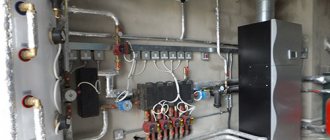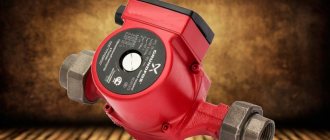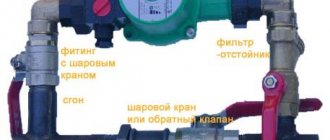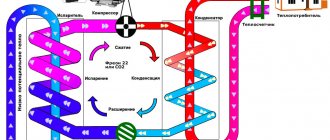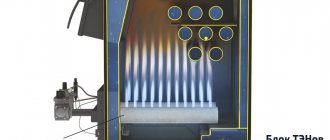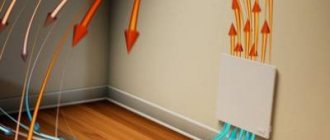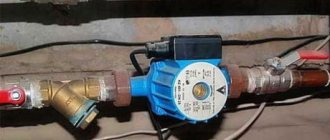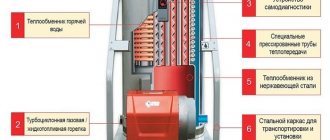Modern boilers from well-known European brands already have a circulation module installed. To modify old heating systems and connect to energy-independent heating equipment, you will need a circulation pump for heating a private home.
Why do you need a pump in a heating system?
Circulation pumps for heating private houses are designed to create forced movement of coolant in the water circuit. After installing the equipment, the natural circulation of liquid in the system becomes impossible; the pumps will operate in constant mode. For this reason, high demands are placed on circulation equipment regarding:
- Productivity.
- Noise insulation.
- Reliability.
- Long service life.
A circulation pump is needed for “water floors”, as well as two- and one-pipe heating systems. In large buildings it is used for domestic hot water systems.
As practice shows, if you install the station in any system with natural coolant circulation, the heating efficiency and uniform heating along the entire length of the water circuit increases.
The only disadvantage of this solution is the dependence of the pumping equipment on electricity, but the problem, as a rule, is solved by connecting an uninterruptible power supply.
Installing a pump in the heating system of a private home is justified both when creating a new one and when modifying an existing heating system.
Operating principle of the circulation pump
The operation of circulation pumps may differ slightly depending on the type of design, but the principle of operation remains the same. Manufacturers offer more than hundreds of equipment models, with various performance and control parameters. Based on the characteristics of the pumps, stations can be divided into several groups:
- According to the type of rotor - to enhance the circulation of the coolant, models with a dry and wet rotor can be used. The designs differ in the location of the impeller and moving mechanisms in the housing. So, in models with a dry rotor, only the flywheel, which creates pressure, comes into contact with the coolant fluid. “Dry” models have high performance, but have several disadvantages: a high level of noise from the pump operation is created and regular maintenance is required. For domestic use, it is better to use modules with a wet rotor. All moving parts, including bearings, are completely enclosed in a coolant medium that serves as a lubricant for the parts that bear the greatest load. The service life of a “wet” type water pump in a heating system is at least 7 years. There is no need for maintenance.
- By type of control - the traditional model of pumping equipment, most often installed in small domestic premises, has a mechanical regulator with three fixed speeds. Regulating the temperature in the house using a mechanical circulation pump is quite inconvenient. The modules are distinguished by high power consumption. The optimal pump has an electronic control unit. A room thermostat is built into the housing. The automation independently analyzes the temperature in the room, automatically changing the selected mode. Electricity consumption is reduced by 2-3 times.
There are other parameters that distinguish circulation equipment. But to choose a suitable model, it will be enough to know about the nuances listed above.
At what speed should the circulation pump operate?
All modern heating systems are equipped with a circulation pump. With the help of which, hot water continuously circulates in the pipes, as a result of which the room is heated. They are available in different configurations and can have 3 speeds: minimum, medium and high.
Adjusting the power of the circulation pump is usually carried out in order to increase or, conversely, reduce its performance. The higher its speed, the faster the hot water passes through the pipes and the more heat it gives off. In turn, the lower it is, the slower the liquid passes through the system, the faster it cools and, accordingly, the heat transfer will be less. The minimum power of heating equipment is set mainly in the spring. At this time, it is already quite warm outside, but the house itself does not warm up enough and there is a need for a little heating of the room. Pump speed modes may vary depending on the model and configuration. On average, the minimum is 30-35 l/min, the maximum is 80-90 l/min.
To ensure maximum performance of the device, it is recommended to check its settings before using it. This is done, as a rule, according to two parameters. Noise insulation. There are several reasons why a heater may make loud noise: improper installation; air in pipes; voltage fluctuations; device malfunction.
To avoid these problems, it is better to entrust the installation to a specialist who will carry out comprehensive diagnostics and ensure the correct installation and functionality of the device. Uniform heating. The main reason for uneven heating of radiators is insufficient power. Low speed contributes to the rapid cooling of the water, as a result of which the heat simply does not reach the end of the system. Airiness or an incorrectly selected thermostat mode also leads to a similar problem. May affect the performance of the device and improper installation. This is especially true for aluminum and bimetallic batteries, which must be installed as level as possible.
How should electronically controlled circulation pumps work? Models with electronic heating type have two types of speed control: manual and automatic. Manual regulation involves setting the power of the device at the desired level. In this case, pressure drops are not corrected.
How to choose a pump for a heating system
The selection of a pump for a heating system begins with an analysis of the parameters of the room and the installed water heating equipment. Additionally, they determine what functions, in addition to increasing the coolant speed, the installed module should perform.
There are several types of circulation pumps offered by different manufacturers. When choosing, you should focus on the quality and reliability of the product, as well as performance parameters.
When choosing a circulation pump for heating a private house, consider the following points:
- Power.
- Equipment manufacturing company.
- Functionality.
How to calculate the power of a circulation pump
An accurate selection based on the area of the house is made only after a thermal audit of the room and heating system. Often, the procedure is expensive and is performed for industrial facilities and apartment buildings. For domestic buildings with a relatively small area, there is a method for calculating a pump without formulas.
You can independently select the power of the circulation pump as follows:
- According to boiler performance. The calculation of a circulation pump for the heating system of a private house is carried out taking into account that 1 kW of water heating equipment power corresponds to a throughput coefficient of 1 l/min. Accordingly, for a 25 kW boiler, you will need to install a pump with a rating of 1500 l/hour.
- Calculation of the pressure of the circulation pump of the heating system. The technical documentation indicates the pressure parameter in meters of water column. Using this parameter, you can determine the length of the water circuit and calculate the required number of pumps in the system. It is believed that for 10 l.m. pipeline, 0.6 m of water column pressure is required. The optimal choice of pump for a 1-story building is standard models with 6 m.v. Art. The stations are suitable for premises with a pipeline up to 100 running meters. If the pressure is not enough, install a second pump or select a more powerful model. The same calculation principle is used when choosing a pump for a 2-story house.
Which brand of circulation pump to choose
The cost of a circulation pump, performance, and operating time directly depend on the manufacturer of the equipment. It is wrong to focus only on price. When choosing a model, it would be a good idea to find out about consumer reviews regarding quality, technical and industrial characteristics.
Judging by the number of sales, the following companies offer the best circulation pumps:
- Grundfos is the world's largest manufacturer of pumping equipment. According to recent estimates, about 50% of all products sold belong to this brand. Grundfos models are distinguished by high reliability and performance. The company has developed and implemented several energy-saving technologies. German pumps are guaranteed to operate for at least 10 years.
- Wilo is another leader in the production of circulation equipment. The German company currently has factories located in several countries, which, however, does not affect the quality of the products. Wilo's product range includes domestic and industrial stations, as well as electronically controlled models.
- DAB is an Italian company with many years of experience in the production of circulation equipment. Since 2002, the operating principle of DAB pumps has been improved at the company's factories, which has led to an increase in the reliability and performance of the equipment, and also reduced noise.
- UNIPUMP is a Russian competitor to well-known foreign brands. The equipment is being manufactured. The product range includes submersible and surface pumps. The main advantage of UNIPUMP is considered to be the low cost of the equipment and full adaptation to the conditions of domestic operation.
- Oasis is a model that is often offered as a Russian product, but actually comes from China. It has factory assembly and quality. The cost, even compared to Russian analogues, is approximately 30% cheaper, which explains the high popularity of the brand. Oasis models are guaranteed to last their entire service life. The equipment is inferior in performance and thermal characteristics to previous manufacturers.
- Wester is another brand that is promoted as English, but actually belongs to the group. Sufficiently reliable models for heating and hot water systems. Wester pumps are suitable for domestic and industrial use, the only drawback is the limited range of products.
How to properly install a heating pump
A detailed pump installation diagram is included in the operating instructions. Proper installation begins with a thorough study of the manufacturer's recommendations.
Connecting a pump to a heating system with your own hands is only possible with special equipment and technical skills. Any violations lead to denial of warranty service, reduced productivity and reduced service life.
Manufacturers recommend adhering to the following rules for installing a pump in the system:
- Installation of a closed home heating system using circulation pumps requires the mandatory connection of a backup power supply. The minimum autonomous power supply time is at least 4-6 hours.
- One- and two-pipe heating systems with a circulation pump require the installation of a bypass. When the electricity is turned off, the forced movement of fluid in the system is replaced by natural movement. Systems with combined coolant circulation are a good solution for frequent power outages in a building.
- It is prohibited to turn on the device at idle speed in a system not filled with coolant. To check the functionality of the electric pump in the heating system, the water circuit is first filled with liquid. Then turn on the pump. If the station is selected correctly, the surface of the radiators will heat up evenly, regardless of their distance from the heating device.
- The optimal pipe diameter is indicated in the technical documentation. Narrowing the cross-section of the water circuit reduces the performance of the pump.
- Connection to the electrical network is made using special terminal connections. There is no need to connect a stabilizer. At the same time, an autonomous power supply for the circulation pump is installed. Read the recommendations regarding choosing a UPS.
- Models with a wet rotor are mounted exclusively in a vertical position.
- A coarse filter is installed in front of the pump.
- To carry out repair work, the installation location of the pump in the system is made accessible.
Where to put the heating pump
The installation location of the pump in the heating system is determined individually, in each individual case. The location is affected by:
- Type of heating system.
- Number of circuits.
On two-pipe and single-pipe heating systems, pumps are installed immediately after the expansion tank. The point is that the station does not pump water into the container. Two- and one-pipe systems with a circulation pump must be equipped with a bypass. The structure is mounted directly in front of the boiler, on the return pipeline.
A heating system with bottom wiring has a huge advantage - the ability to gradually add radiators and install additional circulation equipment. The decision to install a system with a bottom supply of coolant is often made when installing a water circuit in a multi-story building.
A heating system with overhead wiring is usually not necessarily equipped with circulation equipment. The design is designed for natural coolant movement. The circuit is assembled so that the supply pipe is as high as possible above the radiators, and the return pipe is below them. The pump is connected to a pipeline with top wiring anywhere in the circuit, immediately after the expansion tank.
Installation of autonomous heating with a circulation pump in a one- or two-story house, with the simultaneous connection of heated floors, is carried out by installing pumping equipment on each heating system separately (with the exception of models with two electric motors). The station for heated floors is placed in a special mixing unit. Installation is carried out according to the arrows engraved on the pump body and frame.
What circulation pump speed should I choose?
Provided the performance is correctly calculated, the radiators are properly connected and the heating system is installed, in most cases it is possible to set the minimum pump speed. In this mode, less electricity is consumed and mechanical parts are subject to less wear.
The pump must operate in a mode that best matches the parameters of the heating system and boiler performance. You can check the settings as follows:
- Each pump is soundproofed. During operation, the module itself makes a slight noise, comparable to a quiet hum. But, when switching to high speed, the turbulence of the water flows, when passing through the water circuit, creates unpleasant sounds. Recommended speed 1-2 switch position. The third speed mode is used briefly to push through air pockets when filling the heating system with coolant.
- Uniform heating. Adding speed is required in cases where the difference in heating temperature of radiators installed at the beginning and end of the water circuit is more than 1-2°C.
After installing a circulation pump in the heating system of an individual home, economic efficiency increases by 30-40%. Such indicators make the installation of equipment not only recommended, but rather a mandatory measure.
Actually, according to the subject, the question is. At what speed of the central heating system will gas consumption be minimal and heat transfer to the radiators will be maximum? AOGV boiler 23 kW, radiators - M140 cast iron, 7 pieces of 10-12 fins each, system - Leningrad, no regulators on the radiators. The power consumption of the boiler is about 6-8 kilowatts according to the gas meter (constant low flame). The chimney is not very hot, the hand holds it.
alexposter wrote: is the heat transfer to the radiators maximum?
at maximum speed
300 liters per hour.
But at maximum speed, gas and electricity consumption will be maximum. And in Lviv the temperature usually does not drop below -5 degrees. So, to save gas, you need to debug the automation on the boiler.
Yann: - I understand. The higher the speed of movement of the coolant in the system, the more uniform the temperature distribution in the system, and therefore the more uniform the heat transfer. How will pump speed affect gas savings? So I don't have any pump at all. There are no miracles. You need to spend 1 m3 of gas to produce 10 kW of heat. This is how you spend it. You need to spend 8 kW of heat on your area, and you will spend it. And in order to use less gas, you need to reduce the heat loss of your home. And in order to reduce heat loss from your home, you need to insulate it. Or resort to alternative heat sources.
viktor48 wrote: But at maximum speed, gas and electricity consumption will be maximum. And in Lviv the temperature usually does not drop below -5 degrees. So, to save gas, you need to debug the automation on the boiler.
We have a limit - a maximum of 90 km / h, I think in Lviv (by the way, how is your bus plant there? What does it produce?) the same rules
Yann wrote: The higher the speed of movement of the coolant in the system, the more uniform the temperature distribution in the system, and therefore the more uniform the heat transfer. How will pump speed affect gas savings? So I don't have any pump at all. There are no miracles
since with a low natural velocity of the coolant, the heating of the heating system will be weak and, accordingly, not uniform, it will be cooler for the final points, for uniform heating and an increase in temperature in the heating system in general, good circulation is needed due to the constant heating of the coolant, and so the pump equalizes the required temperature in the system and holes in the hydraulics, forced circulation does not require large pipe diameters in relation to natural circulation, hence the ratio of coolant in the system
orinbasar wrote: and so the pump equalizes the required temperature in the system and holes in the hydraulics
Yann: - That's right, if there were errors in the system with natural circulation, then it simply won’t work, with a pump everything is simpler.
orinbasar wrote: forced circulation does not require large pipe diameters in relation to natural circulation
But you need electricity.
orinbasar wrote: hence the ratio of coolant in the system
The more coolant, the greater the thermal inertia of the system, and this is more of a plus than a minus.
Yann wrote: The more coolant, the greater the thermal inertia of the system, and this is more of a plus than a minus.
on gas consumption, the question is under what conditions gas consumption will be minimal
Operating principle of a frequency pump
Using a frequency controlled circulation pump can solve a lot of problems. It determines operating modes for itself, since it instantly adapts to pressure differences in the heating circuit. The frequency converter inside controls the engine speed, and as soon as the resistance in the heating system begins to increase, with the help of a frequency converter, the engine speed is immediately reduced. This allows you to stabilize the outlet pressure and maintain this pressure at a given level. In such conditions, the frequency pump operates in a gentle mode, which has a positive effect on its service life and does not lead to unnecessary energy consumption.
Using a frequency pump, ideal operating parameters are achieved for a heating system that uses thermostatic valves. Also, the absence of pressure drops has a positive effect on the service life of pipe connections and fittings, as well as on the condition of the pipes themselves and the heat exchanger. Also, such pumps have some design features that distinguish these devices from conventional circulation pumps. Pumps with frequency conversion are manufactured using permanent magnets, which can significantly reduce energy consumption.
The frequency generator can be compared to an energy-saving lamp, which, although more expensive than a regular lamp, brings significant savings over long-term use. Frequency-type pumps also save the user’s budget, although the pump itself costs a little more than its classic counterpart. When using a frequency pump in heating systems on a long-term basis, the economic effect is obvious. Frequent pressure drops in the heating circuit can eventually damage a conventional circulation pump, and this element of the heating system is one of the most expensive. The frequency pump operates under optimal conditions and has a twice as long service life.
